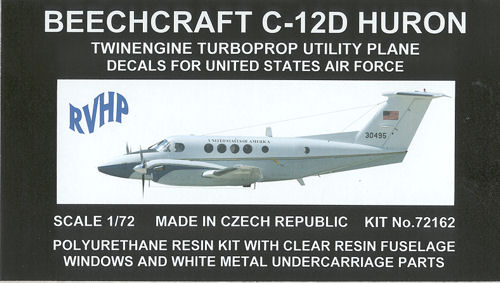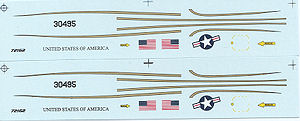
| KIT: | RVHP 1/72 C-12D Huron |
| KIT #: | 72162 |
| PRICE: | $50.00 from Coopers Models |
| DECALS: | one option |
| REVIEWER: | Scott Van Aken |
| NOTES: | Resin with metal landing gear and vac cockpit |

| HISTORY |
The King Air 200 is a continuation of the King Air line, with new features including the distinctive Ttail, more powerful engines, greater wing area and span, increased cabin pressurisation, greater fuel capacity and higher operating weights compared to the King Air 100.
Beech began design work on the Super King Air 200 in October 1970, resulting in the type's first flight on October 27 1972. Certificated in mid December 1973, the King Air 200 went on to be the most successful aircraft in its class, eclipsing such rivals as the Cessna Conquest and Piper Cheyenne. Today the King Air 200 is the only one of the three in production.
The improved B200 entered production in May 1980, this version features more efficient PT6A42 engines, increased zero fuel max weight and increased cabin pressurisation. Sub variants include the B200C with a 1.32m x 1.32m (4ft 4in x 4ft 4in) cargo door, the B200T with removable tip tanks, and the B200CT with tip tanks and cargo door. The Special Edition B200SE was certificated in October 1995 and features an EFIS avionics suite as standard.
Various special mission King Air 200s and B200s have been built, including for navaid calibration, maritime patrol and resource exploration. In addition several hundred Super King Airs have been built for the US military under the designation C12. C12s perform a range of missions from electronic surveillance to VIP transport.
The 1500th commercial King Air 200 was built in 1995. In 1996 Raytheon dropped the `Super' prefix for all 200, 300 and 350 model King Airs.
All branches of the US military have used the King Air with the Army calling it 'Huron'. None of the other services refer to it as anything other than either C-12 or King Air. For years the USAF used the C-12F for short range hauling or for hacks with many units having a C-12 just for that purpose. Many USAF C-12s were used at overseas diplomatic stations for use by the American Ambassador. Most non VIP C-12s are gone from the USAF inventory though some are still used at training commands. The Navy has also used the King Air as the UC-12 for similar missions. Undoubtedly the widest range of uses has been with the US Army where not only are there the usual hack jobs, but dedicated battlefield signal intelligence has been performed with highly modified C-12s.
In addition to the US, the King Air has been used by a large number of foreign air forces.
| THE KIT |
 This is the first RVHP kit I've seen and I have to say that I'm impressed. The molding is superb with finely done engraved detail and a minimum of molding glitches. In fact, a quick survey of the parts showed none that were apparent. You get a complete cockpit with seats, instrument panel and center console along with very finely done control wheels. There are clear resin window inserts and some spares are provided in case one goes astray. The interior also has a number of bulkheads to install. There is no cabin aside from the floor so how one outfits this is up to one's desire and skills.
This is the first RVHP kit I've seen and I have to say that I'm impressed. The molding is superb with finely done engraved detail and a minimum of molding glitches. In fact, a quick survey of the parts showed none that were apparent. You get a complete cockpit with seats, instrument panel and center console along with very finely done control wheels. There are clear resin window inserts and some spares are provided in case one goes astray. The interior also has a number of bulkheads to install. There is no cabin aside from the floor so how one outfits this is up to one's desire and skills.
A very nice touch are separate clear wing tip formation light lenses. The two vac cockpit transparencies are among the finest I've seen in terms of clarity. The kit also has a small lip around the cockpit opening to make it easy to attach the transparency. What a great way to do things.
One is also provided with five propeller blades per side, though I imagine this is as much to handle other King Air variants as anything, but it is nice to have the spares. The landing gear are metal so no worries about resin deformation. They seem well molded but have a ton of flash to clean up. Many of the smaller parts are finely molded and appear to be rather delicate so care will be needed for construction. One will also have to wary of proper sanding of the back of the engine nacelles to keep them flat.
 One set of markings is provided and that is for C-12D 83-0495 as assigned to the 89th AW at Andrews AFB for VIP transport. It is in a two shades of blue and white scheme with gold striping, a most fetching scheme. The decals are well done and you get two sheets to simplify costs. The modeler will have to paint the blue trim and the black de-icing panels. These VIP planes do not have fuselage insignia. Instructions consist of a history and exploded view on one side with the painting guide and decal placement on the other. FS 595 paint references for the blues are given, but no paint matchups.
One set of markings is provided and that is for C-12D 83-0495 as assigned to the 89th AW at Andrews AFB for VIP transport. It is in a two shades of blue and white scheme with gold striping, a most fetching scheme. The decals are well done and you get two sheets to simplify costs. The modeler will have to paint the blue trim and the black de-icing panels. These VIP planes do not have fuselage insignia. Instructions consist of a history and exploded view on one side with the painting guide and decal placement on the other. FS 595 paint references for the blues are given, but no paint matchups.
| CONCLUSIONS |
This really is a superb looking kit, I fully intend to get this one on the bench for a later review. I've always had a fondness for the C-12 and the only other kit in this scale I'm aware of was the Rareplanes vacuformed kit. Those not wanting to use the kit markings can do just about any other King Air 200 you have decals for.
October 2006
| REFERENCES |
My thanks to Coopers Models for the review sample. Get yours direct at the link. If you would like your product reviewed fairly and fairly quickly by asite that has over 325,000 visitors a month, please contactme or see other details in the